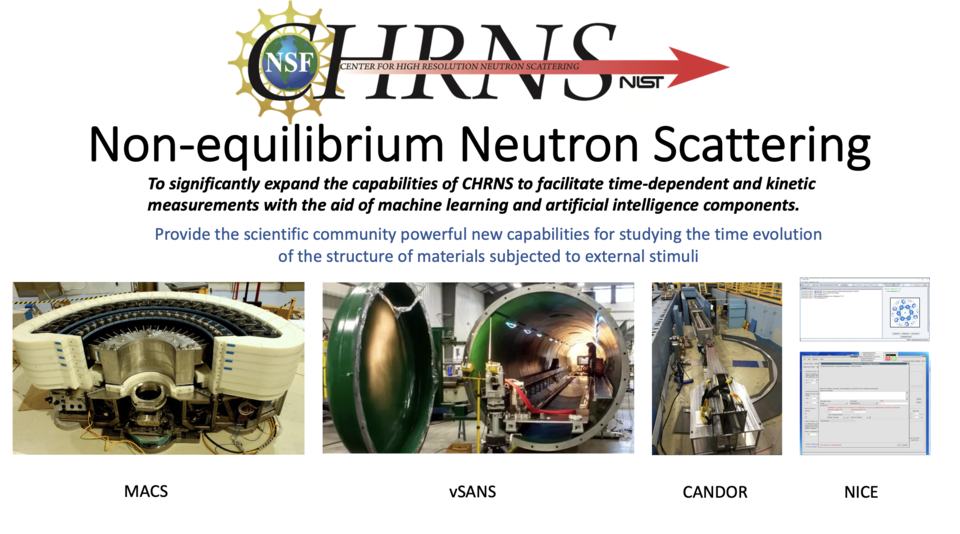Summary
With the advent of vSANS, CANDOR, and MACS, which provide accelerated data rates, and the deployment of the new, more flexible, data acquisition system at NIST, coupled with the rise of machine learning and AI, CHRNS is well-positioned to supply the advanced neutron capabilities required to characterize materials out of equilibrium. Through this initiative, CHRNS will be able to offer the academic community access to exceptional neutron scattering capabilities to address pressing scientific issues.
Description

High level composition of the Kinetics Initiative
The MACS, vSANS, and CANDOR instruments will be upgraded to allow new approaches for time-resolved experiments.
New hardware allows CHRNS users to quickly reduce and analyze their data.
New data streams that incorporate multiple time-resolved data and a new methodology for maintaining the data in an accessible database will be implemented.
Software is available for experimental optimization on CANDOR and vSANS.
A combination of computational power and software tools has been developed to treat the time-stamped data in almost real time for immediate user feedback and AI-based experimental control.
Time-stamping of the instrumental configuration and continuous sample rotation will increase the effective data rates on MACS.
New electrochemical and stopped-flow capabilities Have been developed
Unscheduled Outage Progress (2022-23)
Several parts of the initiative have been accelerated and new targets have been developed to use this time optimally.
FAIR data management (Completed)
Goal: FAIR: Findable, Accessible, Interoperable and Reusable
- ORCID full integration in IMS, NICE control software
- Sample metadata: entry in NICE, automatic population of database
- Extracting and publishing metadata from pre-existing CHRNS-instrument files
- Datafile metadata search page and API
- Experiment metadata search page and API
- Automatic DOI record generation from NICE experiments
- Process metadata pipeline plan for new MACS NICE deploymen
- Data processing manifest exports from reduction for all CHRNS instruments
https://ncnr.nist.gov/ncnrdata/metadata/search/datafiles/
https://ncnr.nist.gov/ncnrdata/metadata/search/experiments/
https://ncnr.nist.gov/ncnrdata/metadata/search/api_docs.html
New CHRNS Sample environments (Completed)
- home-built stopped-flow experimental system
- Commercial stopped flow system
- New electrochemical cells for CANDOR and HFBS
- MACS rotational stage has been integrated into the instrument control process
- Procurements:
- Potentiostat received and passed acceptance testing
- MACS rotational stage designed, engineered, and installed
- CANDOR liquid exchange system robotics components all built
- All significant network hardware and computational resources (despite global supply chain issues)
- Prototype sample-environment and instrument event-mode system
- Server-client architecture
- High-level Standards and Protocols defined
- Version control of Labview libraries
- Device discovery
- Protocols for including device and hardware information in data files for FAIR
- 1-2 shear cell control redesign to work with event-mode and current NICE controls
- Improved furnace and temperature control on
- Event-mode expanded on other rheometers
- In-house stopped-flow system
- Operational flow system with 400 msec effective resolution
- Instrument control scripts and rudimentary automatic data reduction/visualization
- Engagement with key users and experts; feedback has been important in deciding priorities and capabilities
- Improved temperature-controlled sample environment
- Shipped to other facilities for use
- Operational flow system with 400 msec effective resolution
- Autonomous Formulations Lab (nSOFT)
- Inspiration for CANDOR liquid exchange system
- Autonomous data collection for NR
- Demonstrate the viability of autonomous experimentation, where data are analyzed in the context of a predetermined model in real time
- Full simulation works for reflectometers
- Upgraded NCNR motor controls and detector systems to allow for time-stamping
- Upgraded NICE instrument controls to allow for remote scripting and control
- Asynchronous processing allows for complex instrument control while auto-reducing and fitting data for CANDOR
- Full McStas simulation of MACS
- allows full characterization of timing delays from sample to detector (~1 ms) with detection uncertainties
- allows full characterization of the resolution function for data fitting and physics model assignment
- Tools to calculate arbitrary resolution functions are available
- Estimates of timing resolution and delays between sample and detectors for Candor and MACS
- Visualization of MACS event mode data using DAVE Mslice
- CANDOR Biological reflectivity workflow
- Transcribed C++ Library to Python (solid-supported lipid bilayer, membrane-associated protein, peptide, or small molecule)
- Jupyter Notebook workflow for data fitting, v1.0
- Improved functionality to Notebook (post-processing of fit, publication-ready graphs)
- In progress to having web-based functionality;
- Bayesian optimization of experiments
- from above workflow added support for experimental optimizations
- Goal: complete with remote execution capabilities
- Implementing experimental optimization methods for SANS
- Synthetic data generation including measurement uncertainties for SANS
- Coordination with SASView underway
- Complete with remote execution capabilities
- Remote fitting of SANS data in SASView
- Multi-CPU and GPU support for remote fitting
- Separation of computational code from GUI

